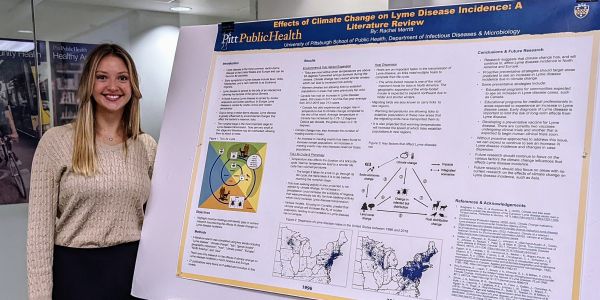
IDM student Rachel Merritt won first place among master’s students for the project, “Effects of Climate Change on Lyme Disease Incidence: A Literature Review”.
Dean’s Day is an annual student research competition. Students present their research during multiple poster sessions while faculty members judge presentations for prizes and students evaluate posters for Grand Rounds credit.
Visit publichealth.pitt.edu/deansday to learn more about the competition and see a full list of winners.
Abstract
Description of the Problem
Lyme disease is the most common vector-borne disease in the United States and Europe. Lyme disease is a tick-borne disease that is spread through the bite of tick carrying the bacteria of the genus Borrelia. Currently, Lyme disease can be found in 80 countries and is endemic in North America, Europe, and Asia. Lyme disease is especially dangerous for the elderly and children. As a vector-borne disease, Lyme disease incidence is affected by the environment and any environmental changes that affect its reservoir.
Objectives/Aims
The purpose of this literature review is to highlight important findings and identify gaps in research that are documenting the effects of climate change on Lyme disease. A literature review on the effects of climate change on Lyme disease incidence has not yet been produced.
Method(s) Used/Approach Taken
A literature search was conducted using key words including “Lyme Disease”, “climate change”, “effects”, “tick”, “genus Ixodes”, “climate zones”, “geographic expansion”, “altitudes”, “host”, “Europe”, “UK”, “North America”, “Asia”, “China”, “Mexico”. These key words were used in the literature search to include findings in all areas where Lyme disease is known to be present. Included studies must be peer-reviewed, published in the last 15 years, focus on both climate change and Lyme Disease, and published in English.
Results
Although research was reviewed for Europe, North America, Asia, and Mexico, there was only research focusing on Lyme disease and climate change within Europe and North America. In recent years studies have concluded that climate change has contributed to the geographic expansion of ticks due to an increase in temperatures. The geographic expansion of ticks has led to an increase in Lyme disease incidence in both North America and Europe. These effects are especially seen in the Northern United States and southern Canada. Climate change also affects the tick life cycle and host population distribution which can influence Lyme disease incidence.
Discussion/Implications/Conclusions
The findings summarized in this review demonstrate that climate change has and will continue to affect Lyme disease incidence and case dispersion. The findings of this review emphasize the need to proactively implement Lyme disease prevention strategies. Identifying populations that are at high risk for an increase in Lyme disease allows interventions to properly target those populations. Some interventions include but are not limited to educational interventions for the public in areas of growing Lyme disease incidence and formulating and distributing a preventative Lyme disease vaccine.
5/09/2022